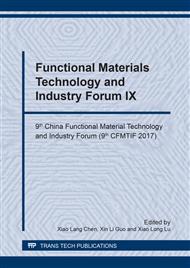p.96
p.102
p.111
p.117
p.124
p.132
p.140
p.151
p.160
Study on Vacuum Tribological Behavior of 9Cr18Mo Bearing Steel by PIII Combined with MS Surface Hybrid Modification Processes
Abstract:
Hybrid modification processes are used to improve the working surface of 9Cr18Mo bearing steel by plasma immersion ion implantation (PIII) combined with magnetron sputtering (MS). The untreated and treated samples were evaluated by the microhardness and vacuum fiction coefficient tests. Wear morphology of surfaces were also evaluated. It has been found that the microhardness of treated samples increased substantially, and the maximum microhardness was increased 31.9%, the adhesion force at the interface of the film and substrate was improved from 79mN to 107mN, the vacuum friction coefficient was decreased from 0.43 to 0.15, the wear scar diameter was reduced 28.6%. By the comparison of the comprehensive properties of different surface modification processes, hybrid process is better than single process.
Info:
Periodical:
Pages:
124-131
Citation:
Online since:
February 2018
Authors:
Price:
Сopyright:
© 2018 Trans Tech Publications Ltd. All Rights Reserved
Share:
Citation:


